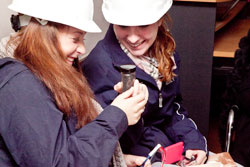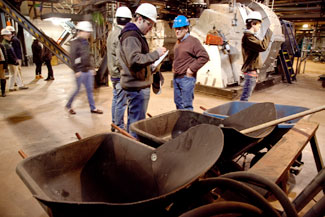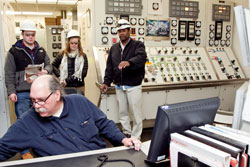 The 21 students of the AP environmental science class trooped into the room at the Mt. Tom Power Plant. The trip had been billed as a tour of the facilities, but the students weren’t exactly sure what to expect.
The 21 students of the AP environmental science class trooped into the room at the Mt. Tom Power Plant. The trip had been billed as a tour of the facilities, but the students weren’t exactly sure what to expect.
Would they get to see the control room? Other parts of the plant? Or just inside of this small room with its rows of chairs and plant diagram?
Station Services Manager Richard Merchant walked into the room and looked around at the seated students. He turned to a fellow engineer.
“Ron, can you pass out the hard hats please?” he said. The class buzzed with excitement. “Yes!” said a few students.
Donning white visitor helmets and goggles, the students headed out on a full tour—one that took them from the turbo sort bag house, six stories up, to buildings full of machinery and control panels.
The plant was not in operation on the day of the visit—and hadn’t been in operation for much of the winter. Since it wasn’t running, the plant had to be continually maintained to keep pipes from freezing and machinery from breaking down.
 “Until two years ago, we ran all the time, 24 hours,” said Edsel Ford, an engineering specialist who served as a guide for part of the tour. “This year, we ran for five days in January and six days in December.”
“Until two years ago, we ran all the time, 24 hours,” said Edsel Ford, an engineering specialist who served as a guide for part of the tour. “This year, we ran for five days in January and six days in December.”
The problem, explained Merchant, was that coal power—even power generated from the relatively cheap coal that the Mt. Tom station shipped in from South America—can’t compete with the low cost of natural gas.
“Right now the costs are two to three times what we would get” in profit, Merchant said. “All energy has issues, and coal certainly does, but the main thing that’s shut down coal plants is economics.”
The Mt. Tom plant also required more workers than a natural gas plant, was up to three times more efficient, took almost 12 hours longer to start up after a period of inactivity, and required multi-million dollar equipment to remove environmental contaminants such as sulphur, nitrogen, and mercury.
As the tour wound out of the conference room and around one side of the plant, Merchant pointed out the $55 million worth of pollution-control equipment that had been installed four years before by plant owners FirstLight Power Resources and GDF Suez North America.
After guiding the students past pulverizers and industrial dust collection equipment, the tour paused in the control room, where Charles Worpek, the engineer on duty, was manning a large bank of computers. One of the students pointed to a phone that connected the plant to power broker ISO New England.
 “It’s like a bat phone,” said Ford. “You pick it up, they’re on the other end. There’s no dialing—they’re there.”
“It’s like a bat phone,” said Ford. “You pick it up, they’re on the other end. There’s no dialing—they’re there.”
After the tour was over, Joey Newlin ‘12 said he felt a sense of wonderment for the man-made structure.
“It’s a hugely complicated process to generate power. I didn’t really know that,” Newlin said. “I thought we’d only get to go to the control room, but we got to see all of it.”


